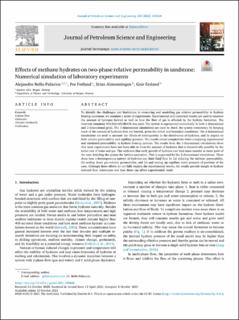| dc.contributor.author | Bello Palacios, German Alejandro | |
| dc.contributor.author | Fotland, Per | |
| dc.contributor.author | Almenningen, Stian | |
| dc.contributor.author | Ersland, Geir | |
| dc.date.accessioned | 2022-04-04T13:08:29Z | |
| dc.date.available | 2022-04-04T13:08:29Z | |
| dc.date.created | 2022-01-17T12:34:52Z | |
| dc.date.issued | 2022 | |
| dc.identifier.issn | 0920-4105 | |
| dc.identifier.uri | https://hdl.handle.net/11250/2989678 | |
| dc.description.abstract | To identify the challenges and limitations in measuring and modelling gas relative permeability in hydrate bearing sandstone, we simulate a series of experiments. Experimental and numerical results are used to examine the amount of hydrates formed as well as how the flow of gas is affected by the hydrate formation. The reservoir simulator TOUGH+HYDRATE was used. The system is represented numerically in both 1-dimensional and 2-dimensional grids. The 1-dimensional simulations are used to check the system consistency by keeping track of the amount of hydrates that are formed, given the initial and boundary conditions. The 2-dimensional simulations are used to measure the effects of heterogeneity in the distribution of hydrates, and its impact on both relative permeability and capillary pressure. The results reveal complexities when comparing experimental and simulated permeability in hydrate-bearing systems. The results from the 1-dimensional calculations show that most experiments have not been able to form the amount of hydrates that is theoretically possible by the initial mix of brine and gas. This indicates that early growth of hydrates can limit mass transfer to inner parts of the core shielding the system for further nucleation. This is supported by the 2-dimensional simulations. These show how a heterogeneous pattern of hydrates can limit fluid flow by (a) reducing the intrinsic permeability, (b) scaling down gas relative permeability, and (c) and scaling up capillary entry pressure of portions of the core. Although these effects do not fully explain the experimental results, the results provide insight to hydrate induced flow restrictions and how these can affect experimental result. | en_US |
| dc.language.iso | eng | en_US |
| dc.publisher | Elsevier | en_US |
| dc.rights | Navngivelse 4.0 Internasjonal | * |
| dc.rights.uri | http://creativecommons.org/licenses/by/4.0/deed.no | * |
| dc.title | Effects of methane hydrates on two-phase relative permeability in sandstone: Numerical simulation of laboratory experiments | en_US |
| dc.type | Journal article | en_US |
| dc.type | Peer reviewed | en_US |
| dc.description.version | publishedVersion | en_US |
| dc.rights.holder | Copyright 2021 The Authors | en_US |
| dc.source.articlenumber | 109606 | en_US |
| cristin.ispublished | true | |
| cristin.fulltext | original | |
| cristin.qualitycode | 2 | |
| dc.identifier.doi | 10.1016/j.petrol.2021.109606 | |
| dc.identifier.cristin | 1982484 | |
| dc.source.journal | Journal of Petroleum Science and Engineering | en_US |
| dc.identifier.citation | Journal of Petroleum Science and Engineering. 2022, 208 (Part D), 109606. | en_US |
| dc.source.volume | 208 | en_US |
| dc.source.issue | Part D | en_US |

